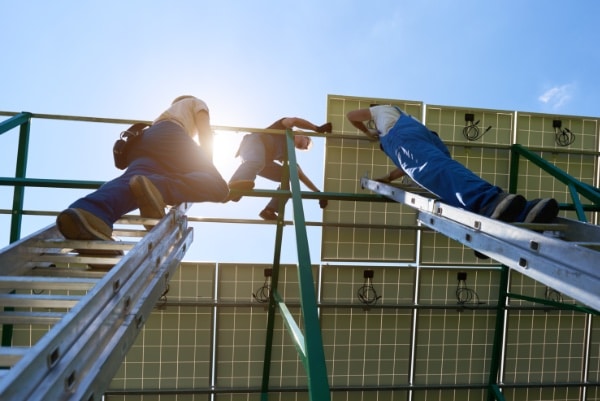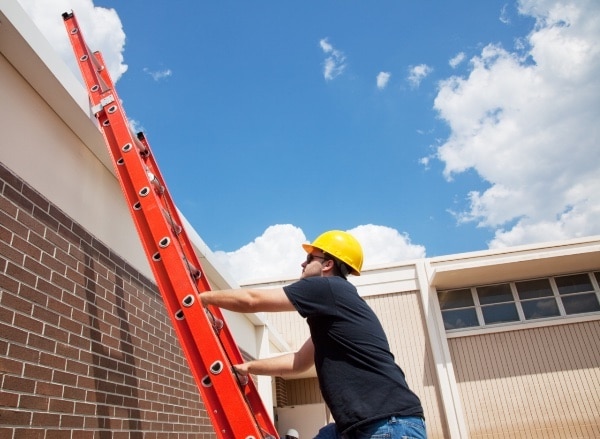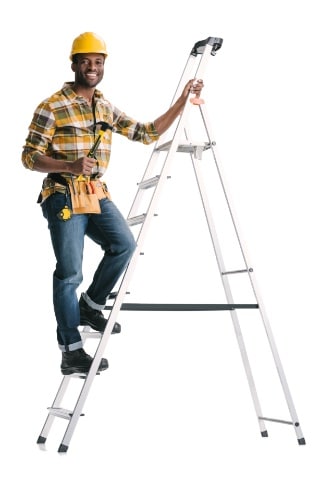Ladder Safety Toolbox Talk – [Quick & Easy Updated for 2023]

Ladder falls cause many workplace injuries and even deaths in the U.S. annually. These tools are an essential piece of equipment in many professions, including construction, roofing, cleaning, and manufacturing. While they seem straightforward to use, the vast majority of preventable accidents have a common cause: poor training. That’s why this ladder safety toolbox talk is so important. You can use this in conjunction with our ladder safety video if you want a full training package.
Our ladder safety guide explores the risks and responsibilities associated with ladder use. We’ll offer guidance on best practices, how to avoid accidents, and employee training options to keep your workers safe.
What are the Safety Procedures in Using Ladders?
Safe use of ladders begins with ensuring that employees know how to inspect and prepare the equipment. Training is usually provided through a course approved by the American Ladder Institute (ALI) and Occupational Safety and Health Administration (OSHA).
Upon successful completion of a course, a student will be tested on their knowledge to ensure that they’re properly trained. Below are the basic safety practices associated with the safe use of ladders.

How to Properly Set Up a Ladder
Falls can be prevented by ensuring that the apparatus is safe to use and set up correctly. This means:
- Performing an inspection before anyone sets foot on the first rung. The locking mechanism on an extension ladder should click into place fully – if it only locks halfway, this is a safety hazard. The rungs shouldn’t be loose and should stand firm when weight is applied. The equipment should be clean, and there should be no signs of rust.
- Propping it up safely. It should lean at a ratio of no more than 4ft vertical to 1ft horizontal – this is known as the 4:1 ratio, which will be covered later. The upper part should be propped against an even surface, and the bottom part should sit on a consistent, solid surface – it should never rest on a movable object.
- Assessing the weather conditions. Except for emergencies, ladders should never be used in high winds or heavy rainfall. Ice and snow are also significant hazards.
- Ensuring easy access for the workforce. Users should never have to step over objects to get onto the first rung. The lowest rung and ground should be easy to access when ascending or descending.
How to Properly Climb A Ladder
Knowing how to climb a ladder seems self-explanatory. So why are so many employees injured each year on the job? Falls can be prevented when your organization implements a proper training program to ensure that each student knows what not to do when climbing.
The most common cause of falls during this stage is bad technique. Employees might feel rushed to complete their duties, which can have critical consequences when climbing. The training course should advise workers to always follow the “3 points of contact” rule, wherein there are always either two hands + 1 foot or one hand + feet in contact with the apparatus.
Training should also observe that making a sudden movement can be a critical mistake in ladder safety. This can overbalance the ladder, throw the person climbing it to the ground, and potentially injure passers-by or other nearby employees. Teaching employees how to climb a ladder correctly is just one of many ladder safety tips that your workers can follow in order to stay safe on the job.
Working at Heights
Workers should always have one hand free to grasp the ladder when needed when working at the top. Employees should try to keep their bodies centered within the confines of the side rails and never lean out too far. Workers also need to know how to tie off a ladder for safety and we have a write up on that as well.
Employees should keep their tools in a belt for easy access and return to the base if they need more tools – they should never be handed or thrown up. Likewise, tools should never be dropped from a height – one of the basics of ladder safety is to avoid creating extra hazards when the environment is already dangerous!

What Protective Gear Do You Need When Climbing Extension Ladders?
Some protective gear may depend on your industry, e.g. construction workers and window cleaners may use different gear. However, ladder users should have the following gear to work safely in all environments.
- Hard hat. Anyone working up or around ladders should wear a hard hat to protect against falling debris and guard your head if you fall.
- Non-slip footwear. Work boots with excellent grip are essential for ladder safety. This is especially important if you’re working in wet or icy conditions.
- Tool belt. Any tools the worker requires should fit easily into a belt that can be accessed with one hand.
- Gloves. Where appropriate (e.g. in freezing conditions), gloves should be worn so that workers can grip the surface more easily.
The right protective equipment can save a worker’s life. Many companies see ladders as such a staple piece of equipment that they don’t see the point of providing a training course for employees. Furthermore, workers may resent the idea of needing to be a “student” for such an everyday task; many workers in the construction industry have worked up ladders all their lives with limited safety training and equipment and “have always been fine.”
The issue is that even if you’re fine 999/1000 times, the 1000th time can be the accident that gives you life-changing injuries. OSHA urges employers to create an adequate training program for workers and support staff who identify shortfalls in current safety practices.
Three Point of Contact Climbing A Ladder
The three-point of contact climbing method states that you should always have either:
- Two hands and one foot on the ladder
- One foot and two hands on the ladder
This helps to keep it stable. Going up extension ladders with only 2 (or even 1) point of contact at a time is risky as it means that if you miss a step, you have almost no support to catch you. Furthermore, if you have only one hand and one foot on the ladder and they’re both on the same side, this creates a weight imbalance that can topple it over.
Using tools with your free hand, you should ideally maintain 3 points of contact even at the top of the ladder. This depends on the job and the type of safety gear you use.

Using Ladders Safely & Fall Protection
Fall protection systems are often a key part of ladder safety. This may take several forms:
- Fall arrest systems & harnesses. Where possible, a harness can be attached to a stable anchor point near the top of the ladder. This allows workers to have both hands free, which is helpful for many maintenance tasks.
- Soft landings. While nets are rarely used alongside ladders as it would be impractical, soft landing areas can be deployed around a ladder for some jobs.
- Restraints. These concentrate on securing the ladder in place, reducing the chance that it falls down. They can be attached to the roof of a property and at the base.
Knowing what type of fall protection measures to put in place is an essential part of ladder safety training for any student. An OSHA-approved training course will include understanding how to identify and set up a stable anchor point.
Do You Need Fall Protection When Climbing a Ladder?
OSHA mandates that fall protection systems be provided for workers using ladders at the height of 24ft or greater. The American Ladder Institute notes that while this is the benchmark for using ladders safely, it’s sometimes advisable to include fall protection for workers even at lower heights, depending on the weather conditions and hazards associated with the job.
For many types of elevated work, these systems must be in place if there’s a risk of a fall over 6ft. It stands to reason that if workers remain at a height for extended periods and don’t need to move up and down the ladder constantly, some form of protection would be a part of safe use.
Choosing an Anchor Point
A training course should explain the importance of finding a secure anchor point for fall protection systems. This can’t be on the ladder, as it’s fundamentally unstable. It should ideally be fastened to an immovable object, e.g. a wall.

What is the 4 to 1 Rule for Ladder Safety?
The 4 to 1 rule indicates that ladders should rise a maximum of 4ft vertical for every 1ft horizontal. This means that the weight of the employee is unlikely to topple the ladder backward.
The 4-to-1 rule isn’t a hard-and-fast legal requirement, but it’s good practice to ensure that workers are trained to identify the right angle. This lets them carry out work faster in the future, as they’ll be able to set up for safe use easily.
Inspecting & Maintaining Ladders
An inspection should be carried out before work starts. Workers should check to ensure that each rung is secure and that the locking mechanism works properly. Steps should be clean and free from grease or oil – if you work with slippery materials, ensure that these are scoured from the steps and rails after use.
If the inspection identifies a problem, the ladder shouldn’t be used. It should be sent off for maintenance or replaced.
FAQ
What are 3 ladder safety rules?
Examples of 3 safety rules include:
- Ensure it’s securely propped up before use.
- Wear non-slip footwear.
- Don’t lean while climbing the ladder.
What is the standard distance between rungs on a ladder?
The general distance between bars is 10″-14″, with almost all models measuring 10″-12. The spacing must be consistent across the whole structure.
What are the five steps to ladder safety?
The first step you take should tell you if you should continue or not. If stepping on the lowest rung makes it wobble, you shouldn’t be taking any more steps!
There are no “5 golden rules” for safety. Common sense and high-quality training will keep you safe, along with the appropriate safety gear wherever necessary.
Final Thoughts
If your workplace uses ladders, it’s your responsibility to keep your workers safe. Use some of the ideas found in this Ladder Safety Toolbox Talk to engage your crew about how to safely use a ladder. It benefits both you and the employee alike!